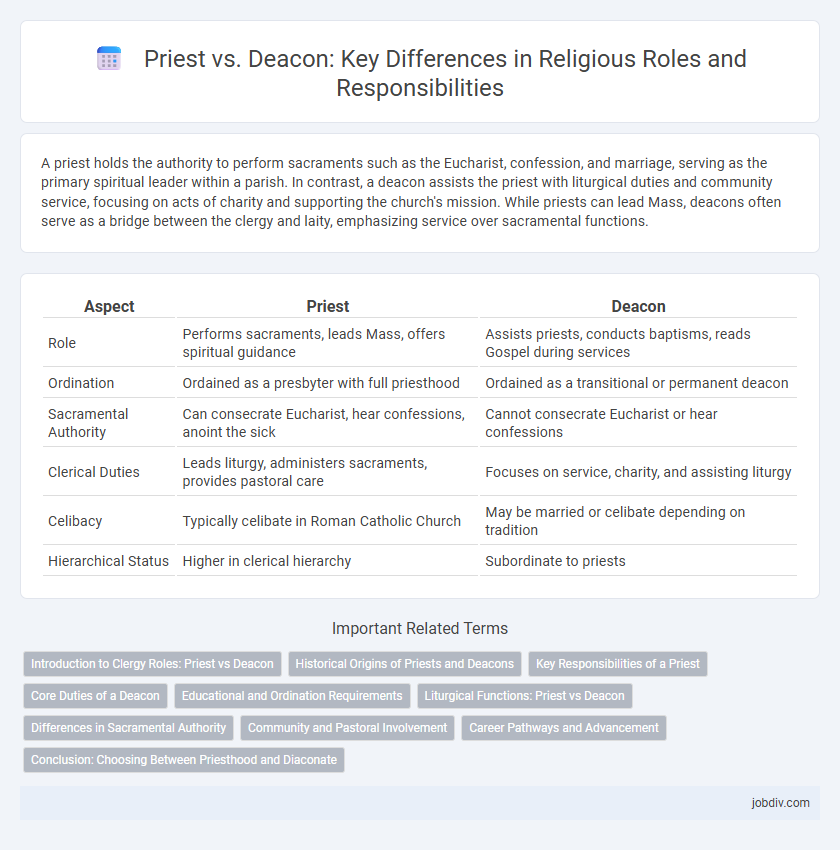A priest holds the authority to perform sacraments such as the Eucharist, confession, and marriage, serving as the primary spiritual leader within a parish. In contrast, a deacon assists the priest with liturgical duties and community service, focusing on acts of charity and supporting the church's mission. While priests can lead Mass, deacons often serve as a bridge between the clergy and laity, emphasizing service over sacramental functions.
Table of Comparison
| Aspect | Priest | Deacon |
|---|---|---|
| Role | Performs sacraments, leads Mass, offers spiritual guidance | Assists priests, conducts baptisms, reads Gospel during services |
| Ordination | Ordained as a presbyter with full priesthood | Ordained as a transitional or permanent deacon |
| Sacramental Authority | Can consecrate Eucharist, hear confessions, anoint the sick | Cannot consecrate Eucharist or hear confessions |
| Clerical Duties | Leads liturgy, administers sacraments, provides pastoral care | Focuses on service, charity, and assisting liturgy |
| Celibacy | Typically celibate in Roman Catholic Church | May be married or celibate depending on tradition |
| Hierarchical Status | Higher in clerical hierarchy | Subordinate to priests |
Introduction to Clergy Roles: Priest vs Deacon
Priests serve as primary spiritual leaders responsible for administering sacraments, preaching, and guiding the congregation in worship, while deacons primarily support priests through ministry of service, assisting in liturgical functions and outreach. The role of a priest encompasses offering the Eucharist and hearing confessions, whereas deacons focus on charity work, baptisms, and proclaiming the Gospel. Understanding these distinct clergy roles highlights the collaborative structure within many Christian denominations, emphasizing both pastoral leadership and service.
Historical Origins of Priests and Deacons
Priests and deacons both trace their origins to early Christian communities where distinct roles developed to serve the growing needs of worship and charity. The office of the priest evolved from the Jewish tradition of the priesthood, becoming central to administering the Eucharist and sacraments, while deacons emerged as appointed servants responsible for charitable works and assisting bishops. Historical documents such as the Didache and writings of Church Fathers like Ignatius of Antioch highlight the early differentiation of these roles within the Church hierarchy.
Key Responsibilities of a Priest
Priests are primarily responsible for administering the sacraments, including celebrating the Eucharist, hearing confessions, and anointing the sick, playing a central role in the spiritual life of the congregation. They provide pastoral care, guidance, and counseling to parishioners, fostering spiritual growth and community cohesion. Unlike deacons, priests have the authority to consecrate the Eucharist and preside over Mass, which are core functions within Catholic and Orthodox Christian traditions.
Core Duties of a Deacon
Deacons serve as ordained ministers tasked primarily with assisting priests in liturgical services, administering baptism, proclaiming the Gospel, and delivering sermons. Their core duties include performing charitable work within the community, supporting the pastoral care of the congregation, and facilitating the distribution of the Eucharist. Deacons also play a vital role in church administration and act as a bridge between clergy and laity, emphasizing service and ministry rather than sacramental authority.
Educational and Ordination Requirements
Priests typically undergo extensive theological education, often completing a bachelor's degree in philosophy followed by a Master of Divinity or equivalent seminary training before ordination. Deacons usually receive shorter, specialized training programs focusing on service, liturgy, and pastoral care, which may be completed concurrently with or prior to seminarians' ordination as priests. Ordination for priests involves the sacrament of Holy Orders granting full priestly authority, whereas deacons receive ordination that empowers them to assist in liturgical roles and charitable ministries without performing all priestly sacraments.
Liturgical Functions: Priest vs Deacon
Priests administer the sacraments, including Eucharist, Reconciliation, and Anointing of the Sick, serving as the primary celebrants during Mass. Deacons assist by proclaiming the Gospel, preparing the altar, distributing Holy Communion, and performing baptisms and marriages but do not consecrate the Eucharist. Liturgically, priests hold the fullness of sacramental authority, while deacons focus on service, charity, and supporting the priest's liturgical role.
Differences in Sacramental Authority
Priests possess the sacramental authority to consecrate the Eucharist, hear confessions, and anoint the sick, roles essential to the administration of most sacraments. Deacons, while ordained, cannot consecrate the Eucharist or hear confessions but have the authority to perform baptisms, witness marriages, and preach during liturgical services. This distinction in sacramental functions highlights the hierarchical structure and specific liturgical responsibilities within Christian clerical orders.
Community and Pastoral Involvement
Priests serve as the primary sacramental leaders within the community, administering the Eucharist, hearing confessions, and offering pastoral guidance through regular Mass and personal counseling. Deacons focus on service-oriented roles, assisting in liturgical functions while actively engaging in charitable outreach, education, and supporting parish ministries. Both roles strengthen community bonds, with priests emphasizing sacramental leadership and deacons enhancing social and pastoral involvement.
Career Pathways and Advancement
Priest career pathways typically involve extensive theological education and ordination, with opportunities for leadership roles such as parish pastor or diocesan administrator, reflecting a higher degree of spiritual authority and sacramental responsibility. Deacons follow a distinct trajectory focused on service, assisting priests and engaging in charitable works, often balancing ministry with secular employment, with pathways including transitions to priesthood if desired. Advancement for priests may include becoming bishops or other ecclesiastical leaders, while deacons primarily advance through increased experience and specialized ministries within the church.
Conclusion: Choosing Between Priesthood and Diaconate
Choosing between the priesthood and the diaconate hinges on one's calling to specific roles within religious ministry; priests primarily administer sacraments and lead congregations, while deacons focus on service, charity, and assisting priests. Vocation discernment involves prayer, guidance from spiritual mentors, and reflection on personal gifts aligned with each role's responsibilities. Commitment to either path offers unique opportunities to serve the faith community, emphasizing pastoral care or diaconal ministry based on God's guidance.
Priest vs Deacon Infographic

 jobdiv.com
jobdiv.com